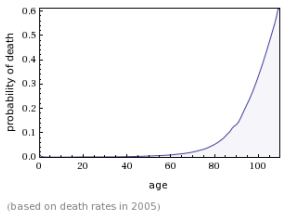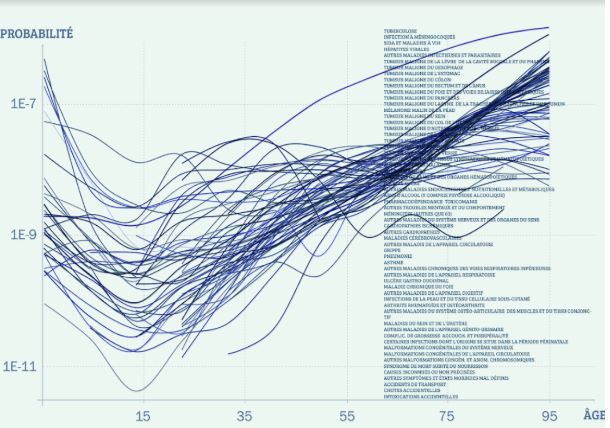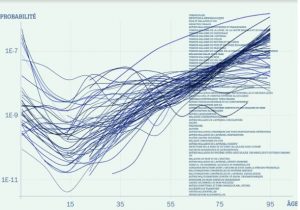Expressions such as “healthy aging” and “aging gracefully” signify that (…) you’re relatively healthy and/or the cosmetic signs of aging aren’t as pronounced as they could be. (…)
This choice of words is rather problematic, especially now that the dawn of rejuvenation is visible on the horizon. The terms “healthy aging” and “successful aging” really are sharp contradictions in terms. If you read the scientific literature on aging, most if not all papers giving general introductions to the phenomenon define it as a chronic process of damage accumulation or a progressive decline in health and functionality. If we try to replace these definitions in the two expressions above, the results are frankly hilarious: “a healthy chronic process of damage accumulation” and “a successful progressive decline in health and functionality”. What’s that even supposed to mean?
Nicola Bagalà, mathematician, artist and life extensionist from the Life Extension Advocacy Foundation (LEAF) in the article Getting sick in a healthy way.
Theme of the month. The periodic doubling of the risk of dying
Exponential growth in the risk of dying in humans
 William Makeham was a British actuary and mathematician who lived in the 19th century. He was the first to discover that, for adults, the probability of dying from disease doubled at regular intervals. Represented by a line on a diagram, the risk of death thus follows an exponential upward curve, gentle at first and then increasingly steep.
William Makeham was a British actuary and mathematician who lived in the 19th century. He was the first to discover that, for adults, the probability of dying from disease doubled at regular intervals. Represented by a line on a diagram, the risk of death thus follows an exponential upward curve, gentle at first and then increasingly steep.
This « law » of human mortality is called the Gompertz–Makeham model.
Doubling of mortality occurs approximately every 8 years. In other words, a 70-year-old is about twice as likely to die in their seventy-first year as a 62-year-old is likely to die in their sixty-third year.
In 2018, we live much longer on average than in the 19th century. It seems, however, that Gompertz-Makeham’s law is highly independent of medical progress. When life expectancy increases, mortality curves follow broadly the same logic as before but starting at a greater age.
Understanding this mechanism has been and is still useful for researchers and entrepreneurs who calculate the multiple economic factors influenced by average lifespan. This ranges from insurance premiums to the financing of social security and demographic prospects. On the other hand, the general public is unaware of this, seeing aging as a rather random phenomenon.
Exponential increase in the risk of death in other animals
For animals in captivity (or cultivated plants) therefore without risk of predation, the pattern of the risk of death with age varies. Three broad categories can be distinguished:
- Animal species that have a fairly precise life span. They are often in good health until reproductive age or until the end of the summer and then die quickly. This is the rule for many insect species and for so-called annual plants. The best-known vertebrate in this regard is probably the salmon, but there is also a species of marsupial, the antechinus in which the male dies very quickly after reproduction.
- Living species, especially plants, that have no known senescence mechanism or that do not have exponential growth in the probability of dying with age. This applies to tree species, including the redwood, as well as lobsters and some bivalves.
- Species that, like humans, have an exponential growth in the probability of death.
For species with an exponential increase in the risk of dying, the mortality doubling period will almost always be shorter than in humans since very few animal species have a maximum life span as long as ours.
Generally, anti-aging experiments involve mice or rats. By knowing the mortality tables of these rodents, it is easier to evaluate the effectiveness of a treatment in fighting senescence by comparing the death curves with or without the new therapy without having to wait for the death of all the animals.
Also, given the increasing probability of death with age, it is more useful and easier to examine older animals than younger ones. If a new product or therapy is effective (i.e. increases lifespan), a difference in mortality will appear more rapidly when comparing groups of older mice (more fragile and dying more often) than when comparing groups of young mice.
However, there is a financial barrier to research on older animals: laboratory animals cost more if they are older (because they have to be raised to the right age).
The exponential growth in the risk of death is general for an individual but also specific for most conditions.
Gompertz-Makeham’s law is little known. What is even less known is that this law also applies, with nuances, to most causes of mortality. The diagram above shows the probability of death by age for most causes of mortality on an exponential scale. Whether it is the risk of dying from cancer, cardiovascular disease or neurodegenerative disease, in each case the probability of death increases with age. Even for infectious diseases, the probability increases exponentially. No one thinks that a simple bout of flu is an age-related illness and yet the risk of dying from it is much higher in an elderly person than in a young person.
The Gompertz curve is explained, of course, by all the aging mechanisms that accumulate and ultimately cause death. When therapies can be studied and then put through double blind tests under rigorous scientific conditions, it is conceivable that the exponential progression will be slowed down and indeed perhaps one day will cease to exist.
News of the month : Right to try in the USA for people suffering from incurable diseases
New legislation has just been adopted at federal level in the United States under the name of Right to try. It allows, under certain conditions, people with incurable diseases to try innovative therapies. Some say that this legislation will save patients’ lives thanks to medical advances without having to wait for a bureaucratic approval procedure.
Unfortunately the new legislation in question is still very limited, particularly as regards information on new therapies. Pharmaceutical companies are not obliged to deliver care and have no obligation to publish the results of new treatments in terms of patient survival.
More rigour therefore remains to be obtained in terms of transparency, but awareness of the importance of accelerating medical research for citizens’ health is progressing.
For more information:
- In general, see in particular: heales.org, sens.org, longevityalliance.org et longecity.org
Source of the illustrations : simple curve in the first illustration : awesci.com/gompertz-law-dreadful-law-death, complex curves in the second illustration supplied by LongLongLife.


